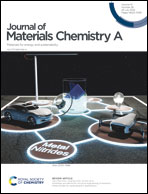Object recognition by a heat-resistant core-sheath triboelectric nanogenerator sensor†
Abstract
Compared to traditional rigid, and energy-consumptive sensors, self-powered flexible sensors have attracted extensive attention. However, few of them can survive at high temperatures, which restricts their application under many extreme conditions. To address this, herein, a novel flexible, heat-resistant and self-powered triboelectric nanogenerator sensor (I-TENG) with a core-sheath structure was developed. The device consists of a double-network ionogel with good stretchability and conductivity as an electrode, aramid fibers as one positive layer and a 3D-printed silicone sheath as the negative layer. Due to the high thermal stability of ionogels, aramid fibers and silicones, the sensing performance of I-TENG can be maintained even at 200 °C. The prepared sensor can not only be twisted, bent and stretched by 200%, but also perceive object information based on finger motion and sensor positions, such as simple shapes and weights. Moreover, the output data were processed using the support vector machine (SVM) algorithm to classify different weights with an accuracy of 85.00% and different shapes with an accuracy of 90.38%. Looking forward, the I-TENG sensor could be integrated into robotic hands for target recognition or sorting at high temperatures.



 Please wait while we load your content...
Please wait while we load your content...